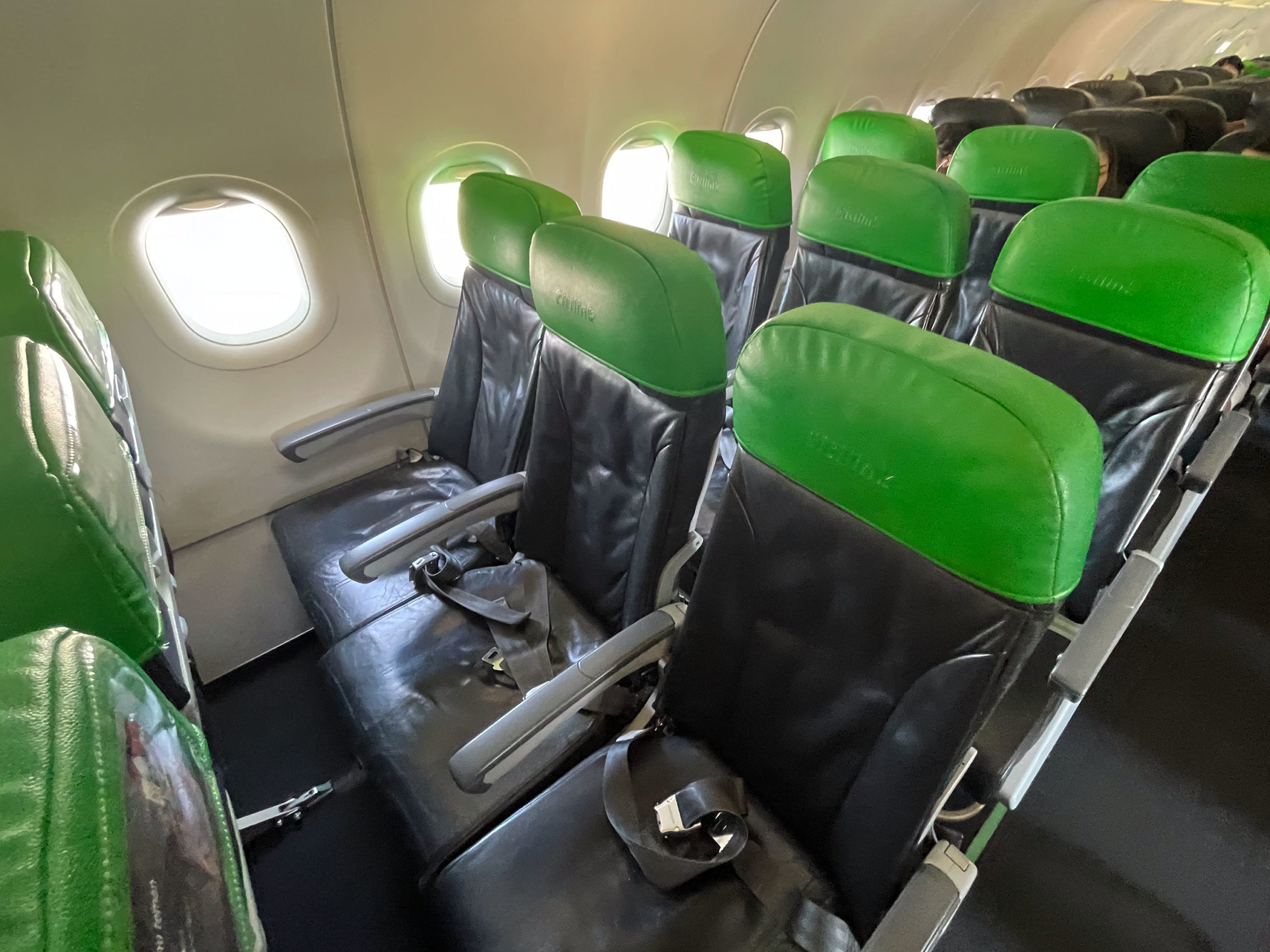
Citilink flight details
Airline : Citilink Indonesia
Flight No : QG685
Departure City : Denpasar – Ngurah Rai (DPS)
Arrival City : Jakarta – Soekarno-Hata (CGK)
Equipment : Airbus A320-200 (PK-GQN)
Blocked Time : 1h50m
Seat No: 1A
Airline Background
Citilink is the low-cost subsidiary of the Indonesian national flag carrier airline, Garuda Indonesia. The airline prides itself as a premium low-cost carrier, using its ties to its parent carrier to evoke this image. Its prices often reflect this image, often pricier than most if not all other Indonesian low-cost carriers. Citilink was founded in 2001 to focus on point-to-point flights, operating Fokker 28 Fellowships. Having shared its AOC with its parent, the airline spun off as an independent airline in 2011. Since then, Citilink has grown into one of Indonesia’s largest low-cost carriers and the most profitable entity of the Garuda Indonesia Group. Today, it flies a fleet of Airbus A320s, A320neos, A330neos, and ATR72s to domestic and limited international destinations.
Booking Citilink
I booked this Citilink flight on their official website about two weeks before the flight and paid a sum of IDR 1,070,000 (~USD69, GBP56). This price is typically higher than those charged by other low-cost carriers like TransNusa, Indonesia AirAsia, or Super Air Jet. On top of that, I spent an extra IDR205,000 (~USD13, GBP11) for a row 1 Green Zone seat and another IDR55,500 (~USD3, GBP2.5) for a meal. Admittedly, these ancillary services are priced much higher than the prices charged by other Indonesian low-cost carriers. This puts the total cost at IDR1,330,500 (~USD85.5, GBP69).
Check-in
For this 14.50 departure, I arrived at Bali’s I Gusti Ngurah Rai International Airport at 13.00. After finding the Citilink check-in counter, I was advised by the agent that their system was having issues and asked us to wait for a bit to check-in. A few minutes later, she requested us to check in online, claiming that Citilink no longer issues printed boarding passes. Huh, okay…? I was suspicious of this claim since my friend flew Citilink a few days prior and had no such issues.
After checking in online, we were all set to go, only for me to notice that virtually everybody else was issued printed boarding passes. Hmmm…. It’s one thing to have a faulty computer, and it’s definitely another to lie about not issuing printed boarding passes! Yikes.
Boarding
After checking in and going through security, I wandered about the terminal looking out for interesting planes. Instead, I saw something that’s a lot more entertaining. As I passed by the gate for the earlier Citilink departure to Jakarta, I noticed that there was a Mickey Mouse sun shade protecting the A320’s cockpit. Now that’s not something you see every day! 😛
I got to the gate at 14.10, ten minutes before the advised boarding time on my mobile boarding pass. Already waiting at the gate was PK-GQN, an Airbus A320-200 delivered new to Citilink in 2016. By this time, the gate was already set up with queue stanchions with a sign advising the boarding procedure.
The boarding sequence started at 14.15 as the gate staff shouted across the hall that the flight was ready for boarding. This was followed by an automated boarding announcement on the intercom. Passengers seated in rows 15-31 were invited to board in three queues. Unlike the case with TransNusa or Indonesia AirAsia, there weren’t any special priority boarding provisions for those seated in front row seats (Green Zone).
As I queued on the jetbridge to board the plane, I noticed that there was an unused ATR72-500 which used to fly for Wings Air parked next to us. There was also a Citilink A320neo and a Lion Air Boeing 737-900ER nearby.
At the door, I was greeted by the friendly crew who stated that this was the flight bound for Jakarta. By this time, boarding was already way underway, which sadly meant that I couldn’t get any empty cabin pictures. Oh well…
Economy Class Cabin
Citilink’s Airbus A320-200 cabin is equipped in a standard all-economy 3-3 configuration. The cabin features a dense configuration of 180 seats, which is the same as you’d find on Indonesia AirAsia and Pelita Air. Of the 180 seats, rows 1 to 5 and rows 12 and 14 are designated as Green Zone seats, denoted by the green coloured headrests. These carry a much higher seat selection surcharge compared to ordinary seats.
Despite having the same amount of legroom, Green Zone seats in rows 2 to 5 go for an additional IDR165,000 (~USD10.5, GBP8.5), which I think is a steep surcharge. First-row and emergency exit row seats go for an even higher IDR205,000 and IDR195,000, respectively. This pales in comparison to the prices charged by TransNusa, Indonesia AirAsia, or Lion Air, which charges about half of that.
Despite being seated in the first row, I quickly went to an empty row to test out the legroom of these seats. With myself standing at 180 cm (5’11), there was around 2 cm between my knees and the seatback. Despite the advertised seat pitch of 29 inches, there was just about 23 cm of space between the seat and the seatback pocket. Suffice to say, it wasn’t great for the price being paid.
Despite the dense configuration, I appreciated that the seat had good padding and was quite comfortable to sit on. The cabin was also clean and well-kept. Individual air vents are also available on the overhead bins, which is always appreciated. Apart from the loud advertisement stuck on the overhead bins, the cabin is nicer than you’d often find on the A320s of European carriers.
First-row Green Zone seat
Back in my seat in the first row, there was an excellent amount of space, as you ought to expect. There was about 40 centimetres of legroom between my knee and the bulkhead, which is undoubtedly a lot more compared to the other rows. As such, I’d probably say that seats in the first and emergency exit rows are the only seats worth paying for.
In these seats, the tray table is pulled out of the centre armrest, revealing a sturdy dining surface. Despite being folded, I was happy to see that it was large and firm enough to accommodate a laptop and serve as a working surface.
In the seat pockets were the typical on board menu catalogues, which I’ll expand on in a bit. There were also a couple of shopping catalogues, alongside a Citilink advertisement leaflet. Additionally, alongside the safety instructions card is a prayer card, as you’d often find on Indonesian airlines.
Departure from Bali
As most passengers settled on their seats, the purser made his welcome announcement in Bahasa and English. Boarding was completed at 14.34 with the plane around 75% full and the door was closed at 14.38. Whilst the regular seats were nearly fully occupied, there were a handful of empty seats in Green Zone. Luckily, I also ended up with an empty middle seat. Woohoo!
After the door was closed, the crew commenced the manual safety demonstration, with instructions in Bahasa Indonesia and English. We pushed back shortly after at 14.48, two minutes before our scheduled departure time. As we taxied to Runway 09, we were being trailed by a Jetstar Boeing 787-8 on its way to Brisbane. After waiting in line for 15 minutes, we finally took off at 15.10.
As we ascended into the skies, we passed by the west side of the island, with the old district of Sanur and the newly revitalised Serangan Island in full view. After clearing the airport, we did a 180-degree turn to head on our way to smoggy Jakarta!
Inflight Service
The seatbelt signs were turned off just six minutes after takeoff, prompting the cabin crew to start preparing for the onboard sales service. Like any other low-cost carrier, Citilink does not provide free refreshments. However, you will receive a free bottle of water if you purchase a seat online. Not that great of a deal though, given how small the bottles are and how pricey the seats are to begin with.
Inflight Dining Menu
For reference, below is the inflight food and beverage menu on offer on my flight. The prices are in Indonesian Rupiahs and items can be purchased by cash, credit card, or BRI Brizzi (a local prepaid cash card). Note that it is also slightly cheaper to prebook a meal online.
Nasi Ayam Betutu meal
Seeing how I’m departing from Bali, I thought it was appropriate to pre-book a Nasi Ayam Betutu meal. After all, Nasi Ayam Betutu is a beloved Balinese dish of heavily spiced fragrant chicken that’s either stewed or fried. Given the number of spices used, I thought this classic dish would do well after being reheated and served inflight. Well, in theory at least.
Sure enough, after the friendly flight attendants distributed bottles of water to those seated in Green Zone, they came back to my seat to confirm my meal preorder. These pre-booked meals are delivered first before the cabin crew passes through the rest of the cabin with the sales menu. My meal was served piping hot on a small tray, with another bottle of water.
The Nasi Ayam Betutu meal consists of shredded Betutu-flavoured chicken, served with white rice, Balinese-style green beans (lawar), fried peanuts, and half of a boiled egg. At first glance, the meal looked pretty good and smelled the part. But as I looked closer, it soon became obvious how little chicken there was in it. Although the chicken was relatively flavourful, there wasn’t enough to go with the rice and the whole dish.
In fact, the meal got bland enough that I had to resort to using the ‘Extra Hot’ chilli sauce provided on the side (which I never use). A bit disappointing, given the higher price compared to the meals on other low-cost carriers.
Inflight Entertainment
When checking out the cabin, I was surprised to see a sticker prominently advertising a streaming system called ‘LinkTertainment’. I can’t say with certainty how popular inflight streaming systems are among passengers in Indonesia. Still, it is offered on other Indonesian carriers like Lion Air, Super Air Jet, Batik Air, and Pelita Air. I guess it must be big enough a fuss for Citilink to introduce its own system.
Unlike those airlines, Citilink’s streaming service conveniently does not require a pre-downloaded app. Instead, after connecting to the Linktertainment network on your device, scan the seatback barcode to open a browser page to linktertainment.com.
The content is outsourced from a provider called Bluebox, featuring a modest number of Indonesian movies, games, and magazines. On my flight, I counted a total of 14 movies (all Indonesian), alongside 12 Citilink-sponsored travel videos. There was also a total 14 magazines, comprising eight issues of Otomotif, three issues of Dewi, two issues of National Geographic, and four issues of Linkers Inflight Magazine. The inflight shopping catalogue was also available for browsing.
Given the modest selection was how ad-ridden the system was, I didn’t find myself thinking it to be useful. I don’t imagine the content would be interesting to non-Indonesian speakers, either. But I’m certain there are others who think differently. In any case, Linktertainment is objectively much weaker compared to the Tripper system offered on the Lion Air Group airlines and Pelita Air.
Lavatory
Before landing, I quickly took time to visit the lavatory to freshen up. I found the toilet to be clean and well-kept, which is about the most you could expect from a low-cost carrier. Nice.
Arrival in Jakarta
About 25 minutes before landing, the captain went on the intercom to announce the details of our descent and arrival. In particular, we were expected to land on time in good weather. Sure enough, the seatbelt signs were lit 15 minutes later, at which time the cabin was prepared for landing. We finally landed at 15.40 on Runway 7R to see a smog-ridden Jakarta.
On our way to our gate, we passed by a couple of widebodies, including a Qatar Airways A350-900 and an Etihad Airways Boeing 777-300ER. We also passed by a special-liveried Garuda Indonesia Airbus A330-300. As we taxied past the jetbridges, it soon became clear that we would park at a remote gate. Although I usually dislike disembarking by stairs, Jakarta Terminal 3 is probably the sole exception. As you’ll be dropped at arrivals by bus, this also means that you’ll bypass the borderline ridiculous walking distance from the terminal’s furthest gates.
We got to our parking stand five minutes after landing, at which time the crew thanked us for flying Citilink with an Indonesian rhyming poem. Interestingly it took a while for the pilot to turn off the engines and the seatbelt signs. We had to wait another 10 minutes before the airstairs were connected due to a ground operations delay. That’s a first time!
As I was seated in 1A, I was among the first to disembark the plane. When I went out the door, I thanked the crew for the flight and quickly went down the stairs to take a few pictures of our jet. We were then driven to the arrivals by bus.
Verdict
Overall, I had an uneventful flight on Citilink Indonesia. Whilst I found the cabin to be clean and well-kept, I felt that the entire flight experience was very mediocre. Despite marketing itself as a premium low-cost carrier, the entire experience felt like a flight on any ordinary low-cost airline. I’d note that the paid food and the legroom weren’t great and the seat selection fees are a lot higher compared to competing airlines. Although nothing stood out to be especially bad, I wasn’t sure if the product warrants Citilink’s higher price difference compared to other low-cost carriers. As such, I wouldn’t mind flying Citilink, although I wouldn’t go out of my way to recommend it, either.


Leave a Reply